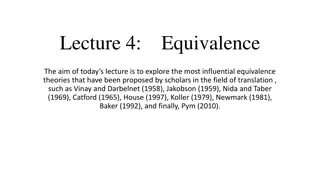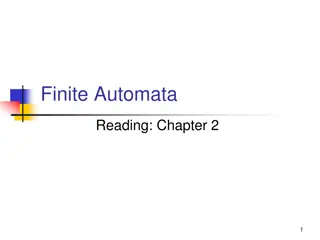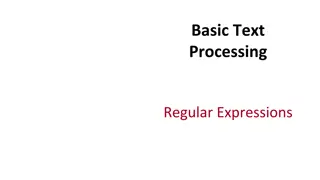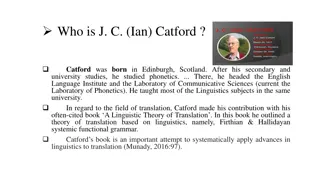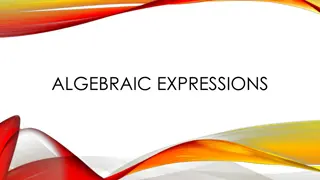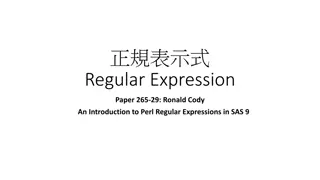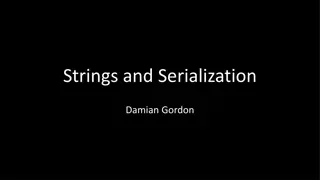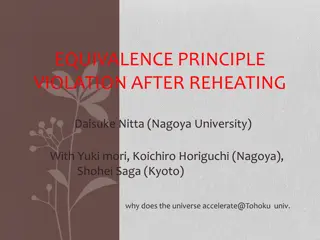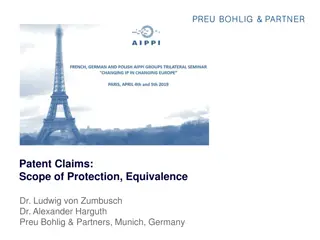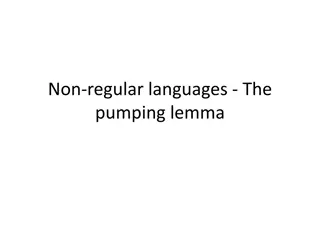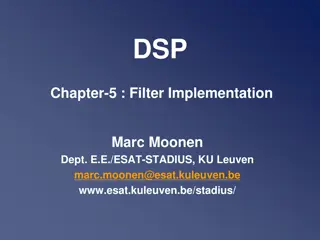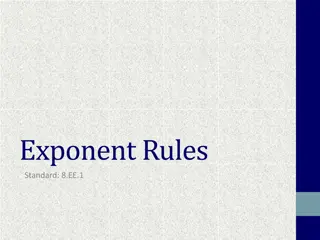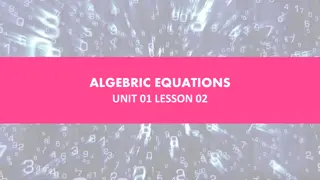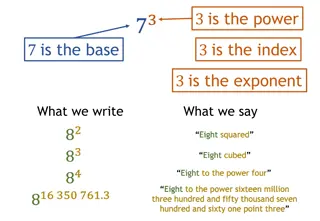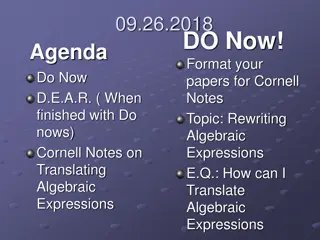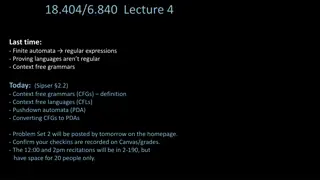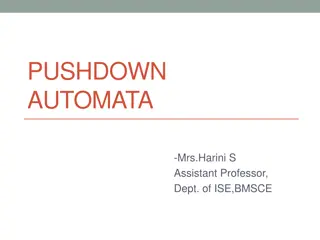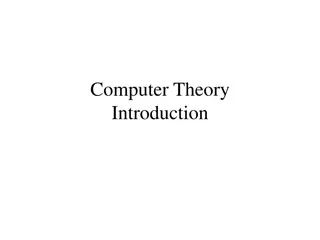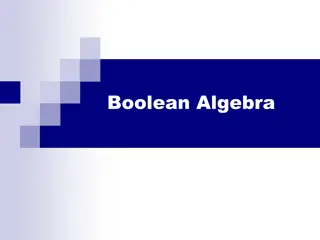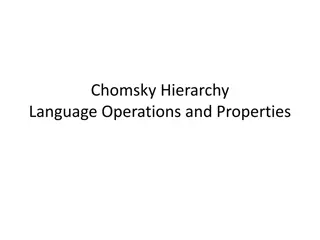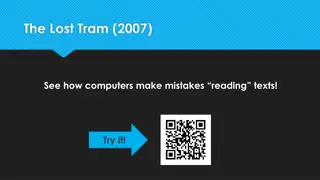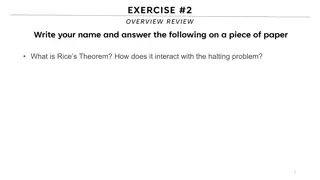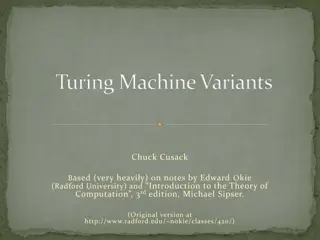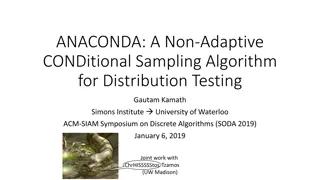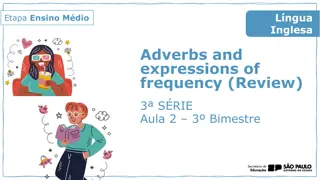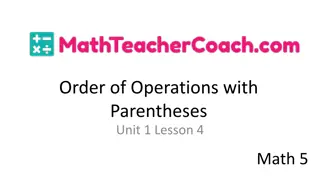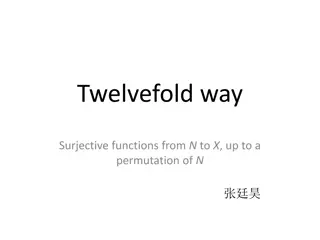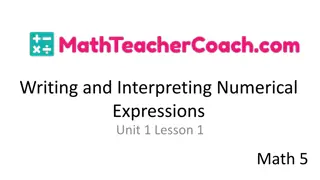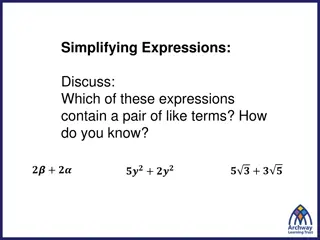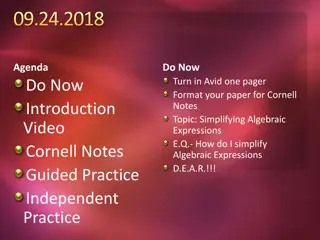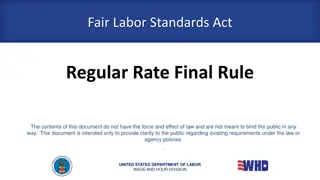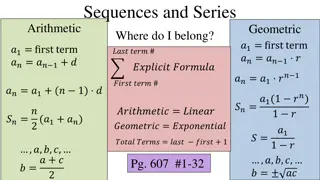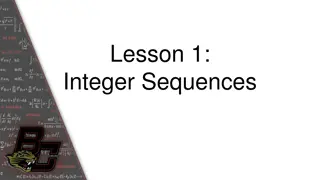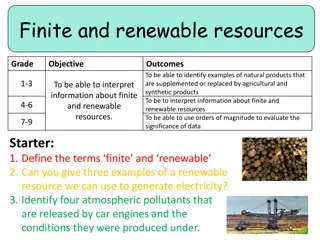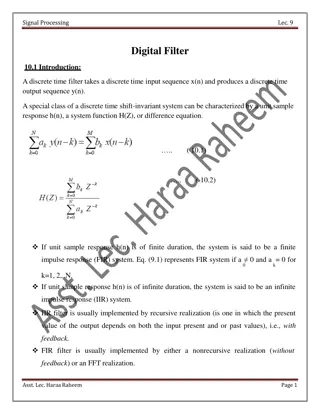Equivalence of Regular Expressions and Finite Automata
Regular expressions are an algebraic method to describe languages, specifically the regular languages. They are defined recursively based on symbols and operations such as concatenation and closure. Precedence rules and examples are also provided. The equivalence between regular expressions and finite automata is established, showing that every regular expression corresponds to an -NFA automaton accepting the same language.
Download Presentation

Please find below an Image/Link to download the presentation.
The content on the website is provided AS IS for your information and personal use only. It may not be sold, licensed, or shared on other websites without obtaining consent from the author. Download presentation by click this link. If you encounter any issues during the download, it is possible that the publisher has removed the file from their server.
E N D
Presentation Transcript
Regular Expressions Definitions Equivalence to Finite Automata 1
REs: Introduction Regular expressions are an algebraic way to describe languages. They describe exactly the regular languages. If E is a regular expression, then L(E) is the language it defines. We ll describe RE s and their languages recursively. 2
REs: Definition Basis 1: If a is any symbol, then a is a RE, and L(a) = {a}. Note: {a} is the language containing one string, and that string is of length 1. Basis 2: is a RE, and L( ) = { }. Basis 3: is a RE, and L( ) = . 3
REs: Definition (2) Induction 1: If E1 and E2 are regular expressions, then E1+E2 is a regular expression, and L(E1+E2) = L(E1) L(E2). Induction 2: If E1 and E2 are regular expressions, then E1E2 is a regular expression, and L(E1E2) = L(E1)L(E2). Concatenation : the set of strings wx such that w Is in L(E1) and x is in L(E2). 4
REs: Definition (3) Induction 3: If E is a RE, then E* is a RE, and L(E*) = (L(E))*. Closure, or Kleene closure = set of strings w1w2 wn, for some n > 0, where each wi is in L(E). Note: when n=0, the string is . 5
Precedence of Operators Parentheses may be used wherever needed to influence the grouping of operators. Order of precedence is * (highest), then concatenation, then + (lowest). 6
Examples: REs L(01) = {01}. L(01+0) = {01, 0}. L(0(1+0)) = {01, 00}. Note order of precedence of operators. L(0*) = { , 0, 00, 000, }. L((0+10)*( +1)) = all strings of 0 s and 1 s without two consecutive 1 s. 7
More Examples: REs L((0+1)*101(0+1)*) = all strings of 0 s and 1 s having 101 as a substring. L((0+1)*1(0+1)*0(0+1)*1(0+1)*) = all strings of 0 s and 1 s having 101 as a subsequence. L(1*(1*01*01*01*)*1*) =all strings of 0 s and 1 s having a number of 0 s that is a multiple of 3. 8
Equivalence of REs and Automata We need to show that for every RE, there is an automaton that accepts the same language. Pick the most powerful automaton type: the -NFA. And we need to show that for every automaton, there is a RE defining its language. Pick the most restrictive type: the DFA. 9
Converting a RE to an -NFA Proof is an induction on the number of operators (+, concatenation, *) in the RE. We always construct an automaton of a special form (next slide). 10
Form of -NFAs Constructed No arcs from outside, no arcs leaving Start state: Only state with external predecessors Final state: Only state with external successors 11
RE to -NFA: Basis a Symbol a: : : 12
RE to -NFA: Induction 1 Union For E1 For E2 For E1 E2 13
RE to -NFA: Induction 2 Concatenation For E1 For E2 For E1E2 14
RE to -NFA: Induction 3 Closure For E For E* 15
DFA-to-RE A strange sort of induction. States of the DFA are assumed to be 1,2, ,n. We construct RE s for the labels of restricted sets of paths. Basis: single arcs or no arc at all. Induction: paths that are allowed to traverse next state in order. 16
k-Paths A k-path is a path through the graph of the DFA that goes through no state numbered higher than k. Endpoints are not restricted; they can be any state. 17
Example: k-Paths 1 0-paths from 2 to 3: RE for labels = 0. 1 2 0 0 0 1-paths from 2 to 3: RE for labels = 0+11. 1 1 3 2-paths from 2 to 3: RE for labels = (10)*0+1(01)*1 3-paths from 2 to 3: RE for labels = ?? 18
k-Path Induction Let Rijk be the regular expression for the set of labels of k-paths from state i to state j. Basis: k=0. Rij0 = sum of labels of arc from i to j. if no such arc. But add if i=j. 19
1 Example: Basis 1 2 0 0 0 1 1 3 R120 = 0. R110 = + = . 20
k-Path Inductive Case A k-path from i to j either: 1. Never goes through state k, or 2. Goes through k one or more times. Rijk = Rijk-1 + Rikk-1(Rkkk-1)* Rkjk-1. Goes from i to k the first time Then, from k to j Doesn t go through k Zero or more times from k to k 21
Illustration of Induction Path to k Paths not going through k i From k to k Several times j k From k to j States < k 22
Final Step The RE with the same language as the DFA is the sum (union) of Rijn, where: 1. n is the number of states; i.e., paths are unconstrained. 2. i is the start state. 3. j is one of the final states. 23
1 Example 1 2 0 0 0 1 1 3 R233 = R232 + R232(R332)*R332 = R232(R332)* R232 = (10)*0+1(01)*1 R332 = 0(01)*(1+00) + 1(10)*(0+11) R233 = [(10)*0+1(01)*1] [(0(01)*(1+00) + 1(10)*(0+11))]* 24
Summary Each of the three types of automata (DFA, NFA, -NFA) we discussed, and regular expressions as well, define exactly the same set of languages: the regular languages. 25





